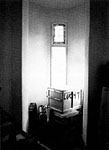These
ideas take some getting used to, and are easy to dismiss with post-1989
hindsight. That Die Fotografie was an organ of the state, and
its advocacy of socialist realism a tool of East German propaganda,
is self-evident. But to state, as Karl Gernot Kuehn does in Caught:
the Art of Photography in the German Democratic Republic, that
the ZKF's editorial control over Die Fotografie represented
"the certain end of the magazine as an occasional platform for
subtle defiance" (Kuehn, p. 57), is ahistorical, untrue, and
unjust to the editors, writers, and photographers whose work for the
periodical did take risks.  Moreover,
searching for evidence of defiance is an inappropriate method for
judging the impact of Die Fotografie on East German culture.
Rather, the ability to work around the editorial mandate of the ZKF,
undermining the theorists of socialist aesthetics by surpassing their
demand for realism, is the key to much East German photography. In
the end, the most powerful defiance was expressed by artists who adhered
to Die Fotografie's most fundamental demand: that they "represent
reality in its revolutionary development… render[ing] man and
his life in all its variety." (DF 12/53, p. 331) Moreover,
searching for evidence of defiance is an inappropriate method for
judging the impact of Die Fotografie on East German culture.
Rather, the ability to work around the editorial mandate of the ZKF,
undermining the theorists of socialist aesthetics by surpassing their
demand for realism, is the key to much East German photography. In
the end, the most powerful defiance was expressed by artists who adhered
to Die Fotografie's most fundamental demand: that they "represent
reality in its revolutionary development… render[ing] man and
his life in all its variety." (DF 12/53, p. 331)
|

 Moreover,
searching for evidence of defiance is an inappropriate method for
judging the impact of Die Fotografie on East German culture.
Rather, the ability to work around the editorial mandate of the ZKF,
undermining the theorists of socialist aesthetics by surpassing their
demand for realism, is the key to much East German photography. In
the end, the most powerful defiance was expressed by artists who adhered
to Die Fotografie's most fundamental demand: that they "represent
reality in its revolutionary development… render[ing] man and
his life in all its variety." (DF 12/53, p. 331)
Moreover,
searching for evidence of defiance is an inappropriate method for
judging the impact of Die Fotografie on East German culture.
Rather, the ability to work around the editorial mandate of the ZKF,
undermining the theorists of socialist aesthetics by surpassing their
demand for realism, is the key to much East German photography. In
the end, the most powerful defiance was expressed by artists who adhered
to Die Fotografie's most fundamental demand: that they "represent
reality in its revolutionary development… render[ing] man and
his life in all its variety." (DF 12/53, p. 331)